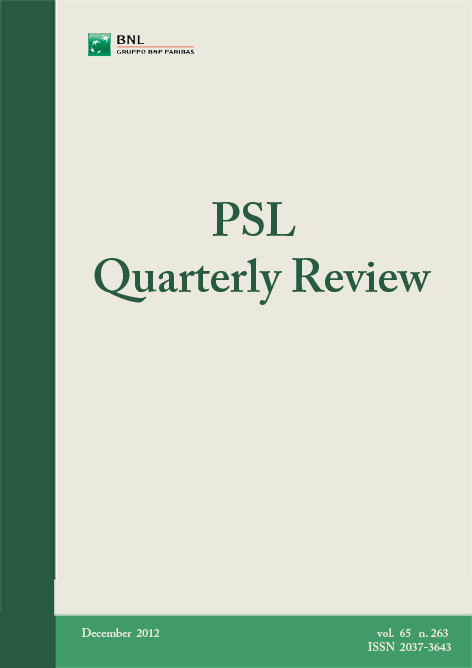The cost and benefit of banking regulations and controls, Chinese style
DOI:
https://doi.org/10.13133/2037-3643/10195Keywords:
China, systemic fragility, allocative efficiency, productive efficiencyAbstract
The neoclassical approach focuses its attention on the prudence of individual banks. In its objective of achieving allocative efficiency, it seeks to prevent market failures caused by the operations of the banks. In this light, it is contended that China should further its market reforms in the direction of fostering the profit maximization cum risk minimization pursuit of individual banks. Meanwhile, the Keynesian-Schumpeterian-Minskyan approach focuses its attention on coping with systemic fragility. And systemic fragility is seen as endemic to the interaction between credit expansion and contraction, productive investment, and business profitability. In this light, even if it is indeed allocatively inefficient, Chinese finance can still have its advantages in terms of promoting productive efficiency.
JEL Codes: G28, E12, E44
References
ALLEN F., QIAN J. and QIAN M.(2005), “Law, Finance, and Economic Growth in China”, Journal of Financial Economics, n. 77, pp. 57-116.
ALLEN F., QIAN J. and QIAN M. (2008), “China’s Financial System: Past, Present, and Future”, in Brandt L. and Rawski T. (eds.), China’s Economic Transition: Origins, Mechanism, and Consequences, Cambridge: Cambridge University Press.
ALLEN F., QIAN J., ZHANG C. and ZHAO M.(2012), “China’s Financial System: Opportunities and Challenges”, in Fan J. and MorckR. (eds.),Capitalizing China, Chicago: University of Chicago Press.
BARTH J.R., CAPIRO G.J. and LEVINE R. (2004), “Bank Regulation and Supervision: What Works Best?”, Journal of Financial Intermediation, n.13, pp.205-248.
CHINA BANKING REGULATORY COMMISSION (2006-2011), Annual Report, Beijing, CBRC General Office.
DIAMOND D. and DYBVIGP. (1983), “Bank Runs, Deposit Insurance, and Liquidity”, Journal of Political Economy, n. 91, pp. 401-419.
HANSON S.G., KASHYAPA.K. and STEIN J.C.(2011), “A MacroprudentialApproach to Financial Regulation”, Journal of Economic Perspectives, n. 25, pp. 3-28.
KASHYAP A.K., STEIN J.C. and HANSON S.G.(2010), “An Analysis of the Impact of ‘Substantially Heightened’ Capital Requirements on Large Financial Institutions”, Booth School of Business, University of Chicago, mimeo.
KREGEL J. (2010), “Is This the Minsky Moment for Reform of Financial Regulation?”, The Levy Economics Institute, mimeo.
LA PORTA, R., LOPEZ DE SLIANES, F., SHLEIFER, A. (1998), “Law and Finance”, Journal of Political Economy, n.106, pp.1113-1155.
LEVINE R. (2002), “Bank-Based or Market-Based Financial Systems: Which Is Better?”, Journal of Financial Intermediation, n. 11, pp. 1-30.
LEVY ECONOMICS INSTITUTE (2012), Using Minsky to Simplify Financial Regulation, New York: Ford Foundation.
LO D., LI G. and JIANG Y.(2011), “Financial Governance and Economic Development: Making Sense of the Chinese Experience”, PSL Quarterly Review, n. 64, pp. 267-286.
MINSKY H.P. (1993), “The Financial Instability Hypothesis”, in Arestis P. and Sawyer M. (eds.), Handbook of Radical Political Economy, Aldershot: Edward Elgar.
WORLD BANK (2012), China 2030: Building a Modern, Harmonious, and Creative High-income Society, Washington D.C.: The World Bank.
Downloads
How to Cite
Issue
Section
License



